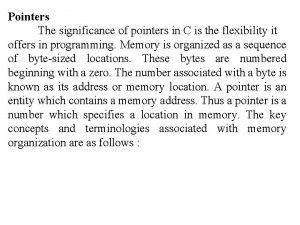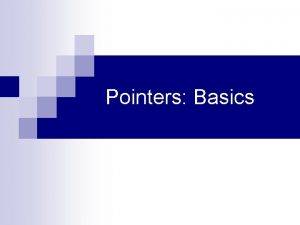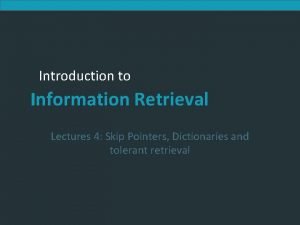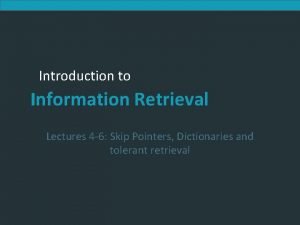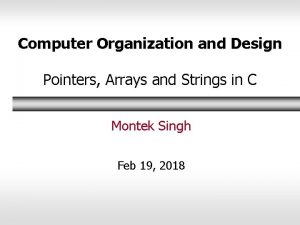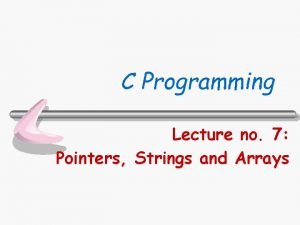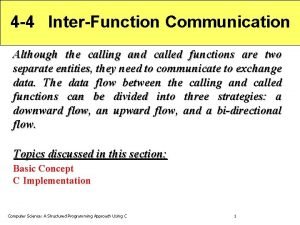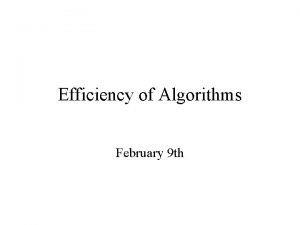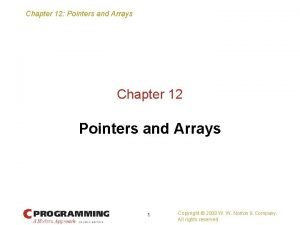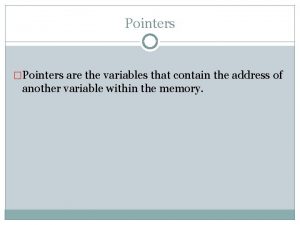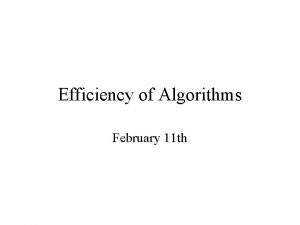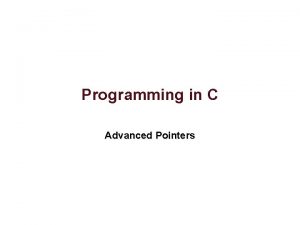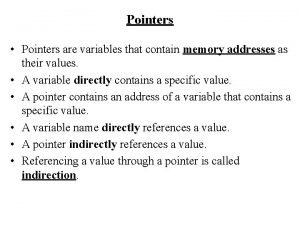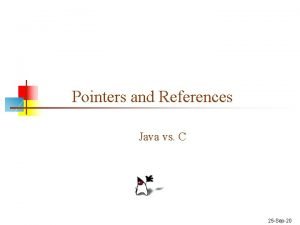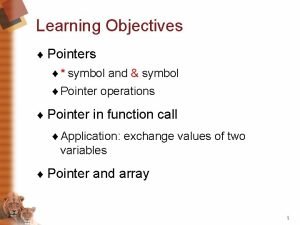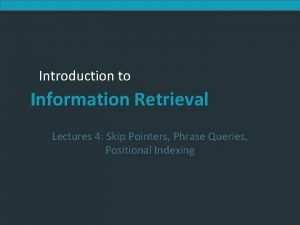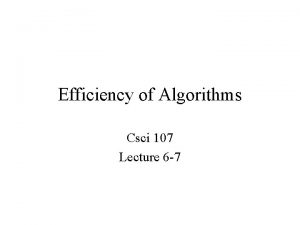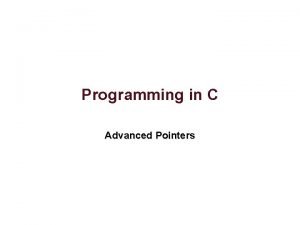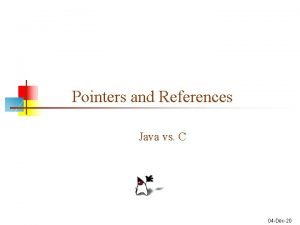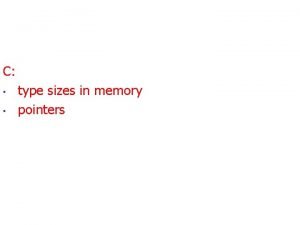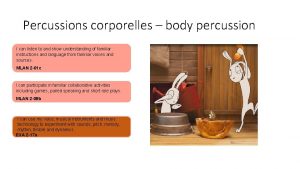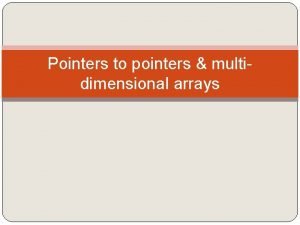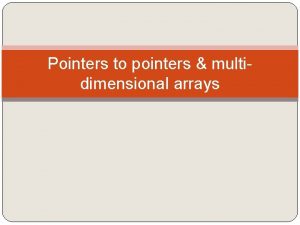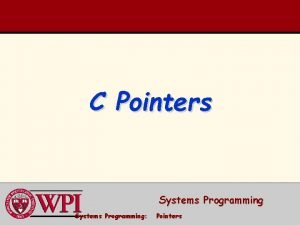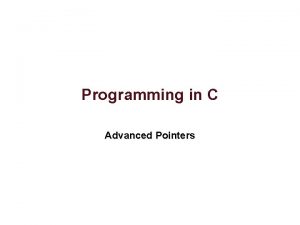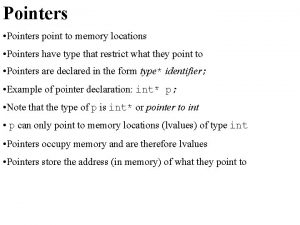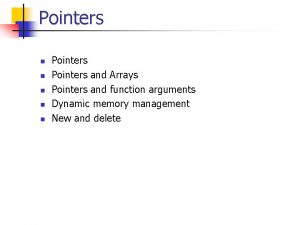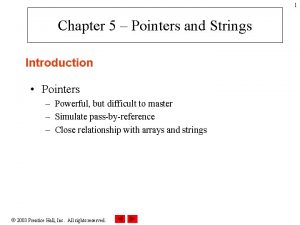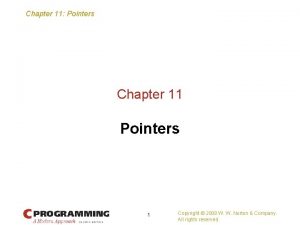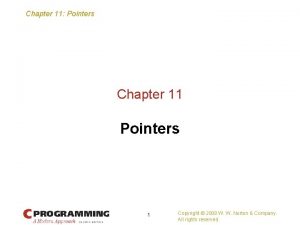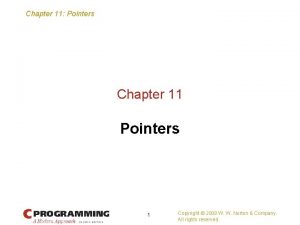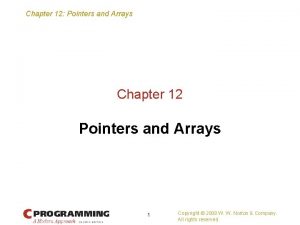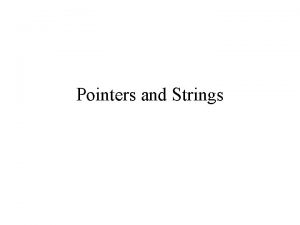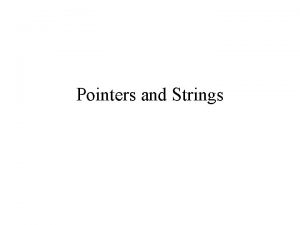Pointers Chapter 10 Introduction To Pointers Pointers can















































- Slides: 47

Pointers Chapter 10

Introduction To Pointers ©Pointers can be the trickiest subject in C and C++. ©You can think of pointers as “shortcuts” in MS Windows. ©It is like a shortcut to memory, variables or many other data types. ©What are pointers for?

Introduction To Pointers © Here are some common uses: © Accessing array elements © Passing arguments to a function when the function needs to modify the original argument. © Passing Arrays and strings to functions. © Obtaining memory from the system. © Creating data structures such as linked lists.

Introduction To Pointers ©Pointers are an important feature of C++ and C. ©Many other computer languages, such as Visual Basic and Java, have no pointers at all. ©(Actually Java has references, which are sort of watered down pointers. )

Introduction To Pointers ©You can do a lot of programming without ever using pointers as we have seen so far up to this point in this class. ©However pointers are a very powerful tool in programming that will allow you to access more data, and represent more complicated data structures.

Introduction To Pointers ©It is common to use pointers to access array elements, pass functions pointers to data. ©In some situations it is essential to use the power of pointers. ©One example is the creation of data structures such as linked lists and binary trees.

Addresses and Pointers ©The ideas behind pointers are not complicated. ©Here is the first key concept: ©Every byte in the computer’s memory has an address. ©Addresses are numbers just as they are for houses on a street.

Addresses and Pointers ©The numbers start at 0 and go up from there, 1, 2, 3, and so on. ©If you have 1 MB of memory, the highest address is 1, 048, 575. (Of course your computer has much more) ©Your program, when it is loaded into memory, occupies a certain range of these addresses.

Addresses and Pointers ©So that means that every variable and every function in your program starts at a particular address.

The Address-of Operator & ©You can find the address occupied by a variable by using the address-of operator &. ©Let’s look at our first example program that uses pointers, “varaddr. cpp”.

The Address-of Operator & © The actual addresses occupied by the variables in a program depend on many factors, such as the computer the program it is running on, the size of the operating system, and whether any other programs are currently in memory. © For these reasons you probably won’t get the same addresses we did when you run this program. (You might not even get the same results twice in a row. )

The Address-of Operator & ©Remember that the address of a variable is not all the same as its contents. ©The contents of the three variables are 11, 22, and 33. ©So remember that when dealing and thinking about pointers, we have both the data values, and the data values address in the computers memory.

The Address-of Operator & © The << insertion operator interprets the addresses in hexadecimal arithmetic, as indicated by the prefix 0 x before each number. © This is the usual way to show memory addresses. © If you aren’t familiar with the hexadecimal number system then don’t worry, all that you really need to know is that each variable starts at a unique address.

The Address-of Operator & ©The addresses appear in descending order because local variables are stored on the stack, which grows downward in memory. ©If we had used global variables, they would have ascending addresses, since global variables are stored on the heap, which grows upwards.

The Address-of Operator & ©Don’t confuse the address-of operator &, which precedes a variable name in a variable declaration, with the reference operator &, which follows the type name in a function prototype or definition. ©References and Pointers are similar but have different purposes.

Pointer Variables © Addresses by themselves are very limited. © It’s nice to know that we can find out where things are in memory, as we did in out last program example, but printing out address values is not all that useful. © The potential for increasing our programming power requires an additional idea: variables that hold address values.

Pointer Variables ©We’ve seen variable types that store characters, integers, floating-point numbers, and so on. ©Addresses are stored similarly. ©A variable that holds an address value is called a pointer variable, or simply a pointer.

Pointer Variables © What is the data type of pointer variables? © It’s not the same as the variable whose address is being stored; a pointer to int is not type int. © You might think a pointer data type would be called something like pointer or ptr. © However, things are slightly more complicated. © The next program, “ptrvar. cpp” shows this.

Pointer Variables ©In our last program example, two integer variables are defined, var 1 and var 2, and initializes them to the values 11 and 22. It then prints their addresses. ©The program next defines a pointer variable in the line int* ptr;

Pointer Variables ©To those who have not seen this syntax before, it might look very strange. ©The asterisk means pointer to. ©So the statement defines the variable ptr as a pointer to int. ©This is another way of saying that this variable can hold the addresses of integer variables.

Pointer Variables ©When I first learned pointers in an introductory C programming class, my professor taught us that the * symbol was like a star, and the pointer with that symbol you could think of as “follow the star” to the data.

Pointer Variables ©You might think that we could have a general pointer variable to declare pointers like this: pointer ptr; ©The problem with that is that the compiler needs to know what kind of variable the pointer points to. ©The syntax in C++ allows pointers to any type to be declared.

Pointer Variables ©char* cptr; // pointer to char ©int* iptr; // pointer to int ©float* fptr; // pointer to float ©Distance* distptr; // pointer to userdefined Distance class ©And it can be done with many others.

Syntax Quibbles ©We should note that it is common to write pointer definitions with the asterisk closer to the variable name than to the type. ©Char *charptr; ©It doesn’t matter to the compiler, but placing the asterisk next to the type helps emphasize that the asterisk is part of the variable type, not part of the name itself.

Syntax Quibbles © If you define more than one pointer of the same type on one line, you need only insert the typepointed to once, but you need to place an asterisk before each variable name. © Char* ptr 1, * ptr 2, * ptr 3; © Or you can use the asterisk next to the name approach. © Char *ptr 1, *ptr 2, *ptr 3;

Pointers Must Have a Value ©An address like 0 x 8 f 4 ffff 4 can be thought of as a pointer constant. ©A pointer like ptr can be thought of as a pointer variable. ©Just as the integer variable var 1 can be assigned the constant value 11, so can the pointer variable ptr be assigned the constant value 0 x 84 ffff 4.

Pointers Must Have Value ©When we first define a variable, it holds no value (unless we initialize it at the same time. ) ©It may hold a garbage value, but this has no meaning. ©In the case of pointers, a garbage value is the address of something in memory, but probably not of something that we want.

Pointers Must Have Value © So before a pointer is used, a specific address must be placed in it. © In our last example program, ptr is first assigned the address of var 1 in the line: © ptr = &var 1; // put address of var 1 in ptr © After that statement, the program prints out the value contained in ptr, which should be the same address printer for &var 1.

Pointers Must Have Value ©The same pointer variable ptr is then assigned the address of var 2, and this value is printed out. ©To summarize: A pointer can hold the address of any variable of the correct type; it’s a receptacle awaiting an address.

Pointers Must Have Value © However, it must be given some value, or it will point to an address we don’t want it to point to, such as into our program code or the operating system. © Rogue pointer values can result in system crashes and are difficult to debug, since the compiler gives no warning. © The result is to make sure that you give every pointer variable a valid address value before using it.

Accessing the Variable Pointed To © Suppose that we don’t know the name of a variable but we do know its address. © Can we access the contents of the variable? © There is a special syntax to access the value of a variable using its address instead of its name. © Let’s look at a program example of this, “ptracc. cpp”.

Accessing the Variable Pointed To ©This last program was very similar to the ptrvar. cpp program, except that instead of printing the address values in ptr, we print the integer value stored at the address that’s stored in ptr. ©The output was: © 11 © 22

Accessing the Variable Pointed To ©The expression that accesses the variables var 1 and var 2 is *ptr, which occurs in each of the two cout statements. ©When an asterisk is used in front of a variable name, as it is in the *ptr expression, it is called the dereference operator.

Accessing the Variable Pointed To ©The dereference operator means the value of the variable pointed to by. ©So the expression *ptr represents the value of the variable pointed to by ptr. ©When ptr is set to the address of var 1, the expression *ptr has the value 11, since var 1 is 11.

Accessing the Variable Pointed To ©When ptr is changed to the address of var 2, the expression *ptr acquires the value 22, since var 2 is 22. ©Another name for the dereference operator is the contents of operator, which is another way to say the same thing.

Accessing the Variable Pointed To ©You can use a pointer not only to display a variable’s value, but also to perform any operation you would perform on the variable directly. ©In the next example, “ptrto. cpp” uses a pointer to assign a value to a variable, and then to assign that value to another variable.

Accessing the Variable Pointed To © Remember that the asterisk used as the dereference operator has a different meaning than the asterisk used to declare pointer variables. © The dereference operator precedes the variable and means value of the variable pointed to by. © The asterisk used in a declaration means pointer to.

Accessing the Variable Pointed To ©int* ptr; // declaration: pointer to int ©*ptr = 37; // indirection: value of variable pointed to by ptr ©Using the dereference operator to access the value stored in an address is called indirect addressing, or sometimes dereferencing, the pointer.

Accessing the Variable Pointed To ©Here is what we have learned so far: ©int v; // defines variable v of type int ©int* p; // defines p as a pointer to int ©p = &v; // assigns address of variable v to pointer p ©v = 3; // assigns 3 to v (direct access) ©*p = 3; // assigns 3 to v (indirect access)

Accessing the Variable Pointed To © The last two statements show the difference between normal or direct addressing, where we refer to the same variable using its address. © In the example programs we have seen so far, there is really an advantage to using the pointer expression to access variables, since you can access them directly. © The value of pointers becomes evident when you can’t access a variable directly, as we will see yet.

Pointer to void ©Before we move on to see real pointers at work, we should check out one strange part of pointer data types. ©Ordinarily, the address that you put in a pointer must be the same type as the pointer. ©You can’t assign the address of a float variable to a pointer to int.

Pointer to void ©For example: ©float flovar = 98. 6; ©int* ptrint = &flovar; //Error can’t assign float* to int* ©There is an exception to this. ©There is a general purpose pointer that can point to any data type.

Pointer to void ©This general purpose pointer is called a pointer to void, and is defined like this: ©void* ptr; //ptr can point to any data type ©These pointers have specialized uses, such as passing pointers to functions that operate independently of the data type pointed to.

Pointer to void ©The next example uses a pointer to void and also shows that, if you don’t use void, you must be careful to assign pointers an address of the same type as the pointer. ©Let’s look at this program, “ptrvoid. cpp”.

Pointer to void ©You can assign the address of intvar to ptrint because they are both type int*, but you can’t assign the address of flovar to ptrint because the first is type float* and the second is type int*. ©However, ptrvoid can be given any pointer value, such as int*, because it is a pointer to void.

Pointer to void ©If for some unusual reason you really need to assign one kind of pointer type to another, you can use the reinterpret_cast. ©For the lines commented out in our last example, they would look like this: ©ptrint = reinterpret_cast<int*>(floatvar); ©ptrflo = reinterpret_cast<float*>(intvar);

Pointer to void ©The use of reinterpret_cast in this way is not recommended, but occasionally it’s the only way out of a difficult situation. ©Static casts won’t work with pointers. ©Old style C casts can be used, but are always a bad idea in C++.
 Caedb
Caedb Exmple
Exmple C array of pointers to structs
C array of pointers to structs Scale factor of pointer in c
Scale factor of pointer in c Which is a good idea for using skip pointers?
Which is a good idea for using skip pointers? For skip pointer, more skip leads to
For skip pointer, more skip leads to Which is a good idea for using skip pointers
Which is a good idea for using skip pointers Explicit pointers
Explicit pointers Pointers and strings
Pointers and strings Pointers in java
Pointers in java Explain inter function communication in c
Explain inter function communication in c Glsl pointer
Glsl pointer Shuffle left algorithm
Shuffle left algorithm Hazard pointers
Hazard pointers 12 pointers
12 pointers I-need-a-few-pointers-98hpou5
I-need-a-few-pointers-98hpou5 Logbook examples for science project
Logbook examples for science project How to write a logbook for a science project
How to write a logbook for a science project Pointers are variables that contain
Pointers are variables that contain What is the fundamental of pointers?
What is the fundamental of pointers? Pointers are variables that contain as their values
Pointers are variables that contain as their values Converging pointers algorithm
Converging pointers algorithm Advanced pointers in c
Advanced pointers in c 9 pointers
9 pointers Pointers are variables that contain
Pointers are variables that contain & vs * in c
& vs * in c Xkcd pointers
Xkcd pointers Pointers symbol
Pointers symbol Skip pointers
Skip pointers Converging pointers algorithm
Converging pointers algorithm Advanced pointers in c
Advanced pointers in c & vs * in c
& vs * in c File pointers
File pointers Pointers in assembly
Pointers in assembly If you can imagine it you can achieve it
If you can imagine it you can achieve it Kinds of comparison
Kinds of comparison If you think you can you can poem
If you think you can you can poem You cant manage what you dont measure
You cant manage what you dont measure If you cannot measure it you cannot manage it
If you cannot measure it you cannot manage it Can can body percussion
Can can body percussion Elements of a curriculum
Elements of a curriculum You can tell harris about it just ____(easily) as i can
You can tell harris about it just ____(easily) as i can Positive degree examples
Positive degree examples I can could speak english
I can could speak english Look at the pictures and complete with can or can't
Look at the pictures and complete with can or can't Were going on a bear hunt we're gonna catch a big one
Were going on a bear hunt we're gonna catch a big one Through you i can do anything i can do all things
Through you i can do anything i can do all things If you can measure it you can manage it
If you can measure it you can manage it

